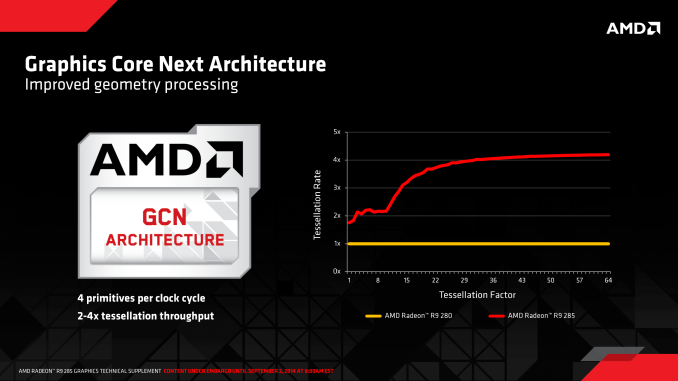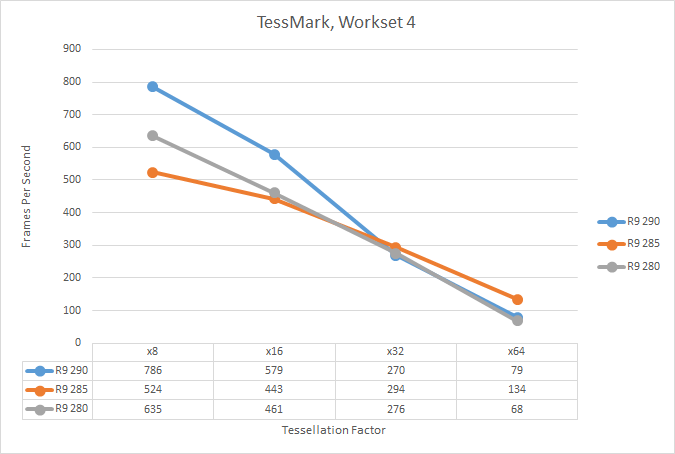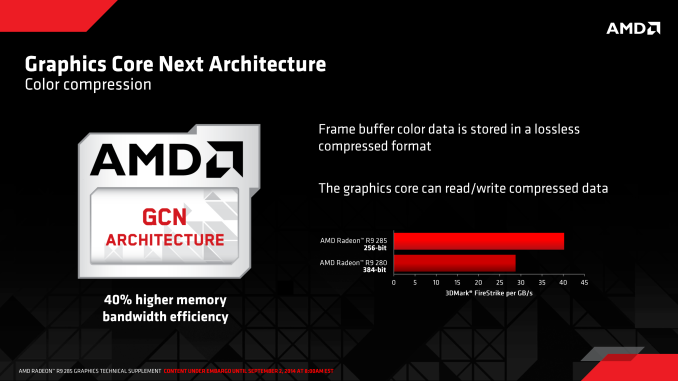AMD Radeon R9 285 Review: Feat. Sapphire R9 285 Dual-X OC
by Ryan Smith on September 10, 2014 2:00 PM ESTGCN 1.2: Geometry Performance & Color Compression
Instruction sets aside, Radeon R9 285 is first and foremost a graphics and gaming product, so let’s talk about what GCN 1.2 brings to the table for those use cases.
Through successive generations of GPU architectures AMD has been iterating on and improving their geometry hardware, both at the base level and in the case of geometry generated through tessellation. This has alternated between widening the geometry frontends and optimizing the underlying hardware, with the most recent update coming in the GCN 1.1 based Hawaii, which increased AMD’s geometry processor count at the high end to 4 processors and implemented some buffering enhancements.
For Tonga AMD is bringing that 4-wide geometry frontend from Hawaii, which like Hawaii immediately doubles upon Tahiti’s 2-wide geometry frontend. Not stopping there however, AMD is also implementing a new round of optimizations to further improve performance. GCN 1.2’s geometry frontend includes improved vertex reuse (for better performance with small triangles) and improved work distribution between the geometry frontends to better allocate workloads between them.
At the highest level Hawaii and Tonga should be tied for geometry throughput at equivalent clockspeeds, or roughly 2x faster than Tahiti. However in practice due to these optimizations Tonga’s geometry frontend is actually faster than Hawaii’s in at least some cases, as our testing has discovered.
Comparing the R9 290 (Hawaii), R9 285 (Tonga), and R9 280 (Tahiti) in TessMark at various tessellation factors, we have found that while Tonga trails Hawaii at low tessellation factors – and oddly enough even Tahiti – at high tessellation factors the tables are turned. With x32 and x64 tessellation, the Tonga based R9 285 outperforms both cards in this raw tessellation test, and at x64 in particular completely blows away Hawaii, coming close to doubling its tessellation performance.
At the x64 tessellation factor we see the R9 285 spit out 134fps, or equivalent to roughly 1.47B polygons/second. This is as compared to 79fps (869M Polys/sec) for the R9 290, and 68fps (748M Polys/sec) for the R9 280. One of the things we noted when initially reviewing the R9 290 series was that AMD’s tessellation performance didn’t pick up much in our standard tessellation benchmark (Tessmark at x64) despite the doubling of geometry processors, and it looks like AMD has finally resolved that with GCN 1.2’s efficiency improvements. As this is a test with a ton of small triangles, it looks like we’ve hit a great case for the vertex reuse optimizations.
Meanwhile AMD’s other GCN 1.2 graphics-centric optimization comes at the opposite end of the rendering pipeline, where the ROPs and memory controllers lie. As we mentioned towards the start of this article, one of the notable changes between the R9 280 and R9 285 is that the latter utilizes a smaller 256-bit memory bus versus the R9 280’s larger 384-bit memory bus, and as a result has around 27% less memory bandwidth than the R9 280. Under most circumstances such a substantial loss in memory bandwidth would result in a significant performance hit, so for AMD to succeed Tahiti with a smaller memory bus, they needed a way to be able to offset that performance loss.
The end result is that GCN 1.2 introduces a new color compression method for its ROPs, to reduce the amount of memory bandwidth required for frame buffer operations. Color compression itself is relatively old – AMD has had color compression in some form for almost 10 years now – however GCN 1.2 iterates on this idea with a color compression method AMD is calling “lossless delta color compression.”
Since AMD is only meeting us half-way here we don’t know much more about what this does. Though the fact that they’re calling it delta compression implies that AMD has implemented a further layer of compression that works off of the changes (deltas) in frame buffers, on top of the discrete compression of the framebuffer. In this case this would not be unlike modern video compression codecs, which between keyframes will encode just the differences to reduce bandwidth requirements (though in AMD’s case in a lossless manner).
AMD’s own metrics call for a 40% gain in memory bandwidth efficiency, and if that is the average case it would more than make up for the loss of memory bandwidth from working on a narrower memory bus. We’ll see how this plays out over our individual games over the coming pages, but it’s worth noting that even our most memory bandwidth-sensitive games hold up well compared to the R9 280, never losing anywhere near the amount of performance that such a memory bandwidth reduction would imply (if they lose performance at all).














86 Comments
View All Comments
Samus - Wednesday, September 10, 2014 - link
Am I missing something or is this card slower than the 280...what the hell is going on?tuxRoller - Wednesday, September 10, 2014 - link
Yeah, you're missing something:)Samus - Thursday, September 11, 2014 - link
BF4 its about 4% slower.Kenshiro70 - Wednesday, September 10, 2014 - link
"something of a lateral move for AMD, which is something we very rarely see in this industry"Really? Seems like the industry has been rebadging for the last two release cycles. How about starting to test and show results on 4k screens? 60Hz ones are only $500 now, and that will put a little pressure on the industry to stop coasting. I have no intention of spending money on a minor bump up in specs. Bitcoin mining demand can't last forever.
tuxRoller - Wednesday, September 10, 2014 - link
Error page 4: chart should read "lower is better"jeffrey - Wednesday, September 10, 2014 - link
Saw this too, the Video Encode chart Ryan.Congrats btw!
Ryan Smith - Thursday, September 11, 2014 - link
Whoops. Thanks.yannigr2 - Wednesday, September 10, 2014 - link
Great article and review.The only bad news here I think is Mantle.
But on this matter, about Mantle, maybe a slower processor could show less of that performance drop or even keep performing better than DirectX11. Maybe one more test on a slower core, on an FX machine?
mapesdhs - Wednesday, September 10, 2014 - link
What were AMD thinking? How can the 285 be a replacement for the 280, given itsreduced VRAM, while at the same time AMD is pushing Mantle? Makes no sense at all.
Despite driver issues, I'd kinda gotten used to seeing AMD be better than NVIDIA in
recent times for VRAM capacity. A new card with only 2GB is a step backwards. All
NVIDIA has to do is offer a midrange Maxwell with a minimum 4GB and they're home.
No idea if they will. Time will tell.
Ian.
Alexvrb - Wednesday, September 10, 2014 - link
There you have it, and with no issues with boost. Sorry Chizow, so much for that. :PThanks for the in-depth review, Ryan. It appears that power consumption is going to vary from implementation to implementation. Lacking a reference model makes it tricky. Another review I read compared Gigabyte's Windforce OC 285 to a similarly mild OC'd 280, finding a substantial difference in the 285's favor.